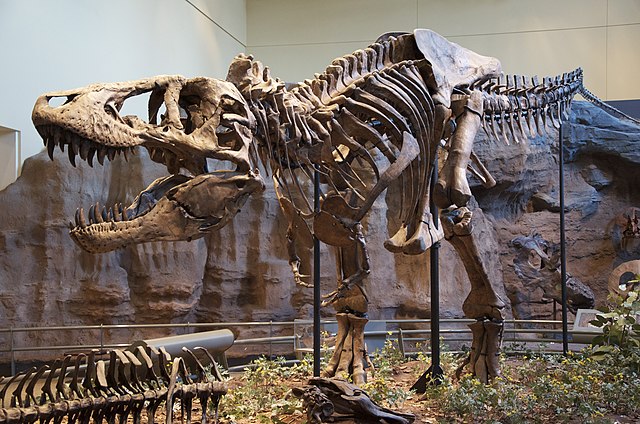Tyrannosaurus rex, often abbreviated as T. rex, was a large theropod dinosaur that lived during the Late Cretaceous period, approximately 68 to 66 million years ago. One of the most iconic features of T. rex was its powerful bite, and unraveling the evolution of its jaws provides insights into its feeding behavior and predatory adaptations:
1. Tooth Structure:
- Denticles: T. rex had large, serrated teeth with denticles (serrations) on the edges. These features facilitated efficient cutting through flesh and bone.
- Replacement Teeth: Like other theropods, T. rex continually replaced its teeth throughout its life. New teeth would emerge to replace any that were lost or damaged.

2. Jaw Strength:
- Muscular Jaws: T. rex had robust, muscular jaws that could generate an immense amount of force.
- Bite Force: Estimates of T. rex’s bite force vary, but it is generally believed to have had one of the most powerful bites among land animals.
3. Cranial Adaptations:
- Skull Structure: The skull of T. rex was large and robust. It had a deep, U-shaped snout, and its jaws were adapted for powerful biting rather than a more delicate, gripping bite.
- Binocular Vision: T. rex had forward-facing eyes, providing it with binocular vision. This likely contributed to depth perception and accurate targeting of prey.
4. Feeding Behavior:
- Carnivorous Diet: T. rex was a carnivore, and its feeding behavior is thought to have involved scavenging as well as active hunting.
- Large Prey: While it could take down large prey, T. rex might have scavenged carcasses, using its powerful jaws to break bones and access the nutrient-rich marrow.
5. Evolutionary Context:
- Theropod Lineage: T. rex was part of the theropod lineage, a group of bipedal, carnivorous dinosaurs. Within the theropods, T. rex belonged to the Tyrannosauridae family.
- Evolutionary Trends: The evolution of powerful jaws and robust teeth is a trend seen in various theropods, reflecting adaptations for different feeding strategies.
6. Ontogeny and Growth:
- Ontogenetic Changes: The jaws of T. rex underwent changes during its growth. Juvenile T. rex had more slender skulls and different dentition compared to adults.
- Heterodonty: The differences in tooth shape and size between juveniles and adults are an example of heterodonty, where an animal has different types of teeth in its lifetime.
7. Trophic Interactions:
- Ecological Role: T. rex likely played a key role in its ecosystem as an apex predator, influencing trophic interactions and shaping the distribution of other species.
- Interactions with Herbivores: The presence of a top predator like T. rex would have influenced the behavior and distribution of herbivorous dinosaurs in its environment.
8. Paleopathology:
- Evidence of Injury: Some T. rex fossils show evidence of injuries, including bite marks and healed fractures. These findings provide insights into the interactions and social dynamics within the species.
The mighty bite of Tyrannosaurus rex is a subject of ongoing research and fascination in paleontology. The study of its jaws and feeding adaptations provides valuable insights into the life of this iconic dinosaur and its role in ancient ecosystems.











